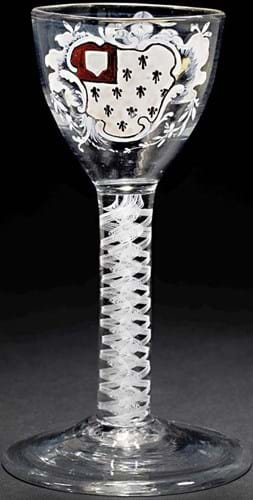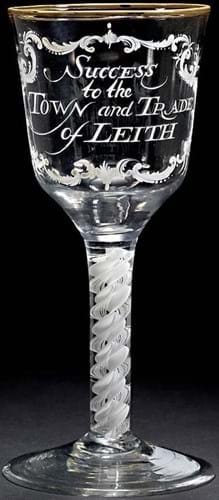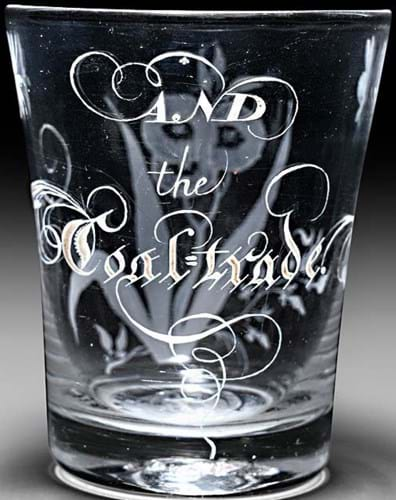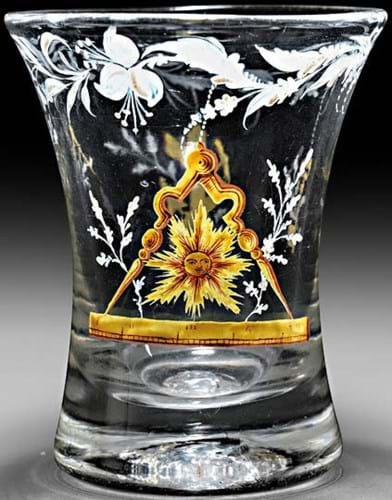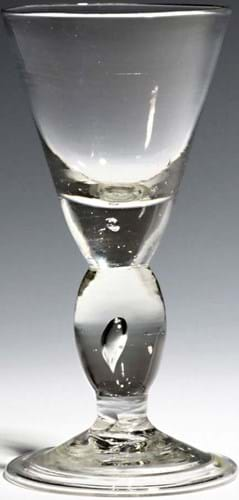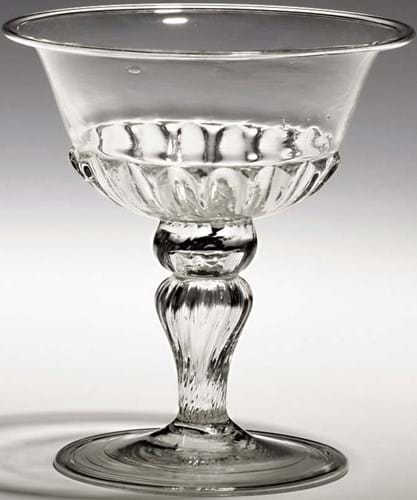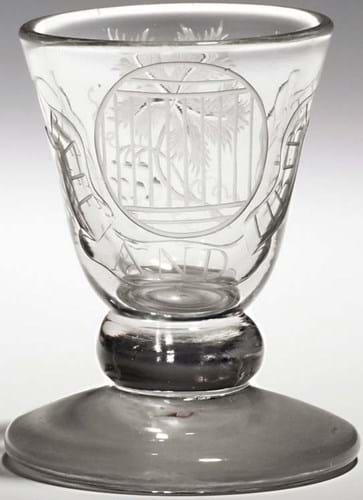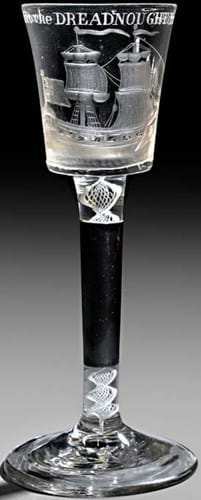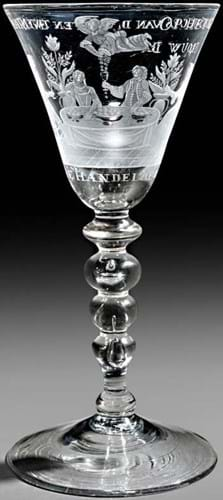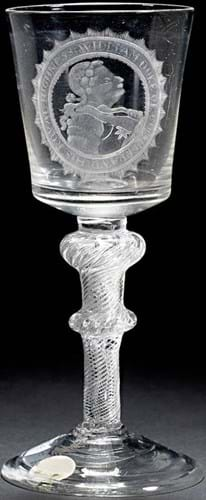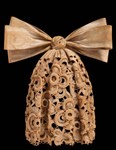Faced with the prospect of no male heir to his Redworth Hall estate, the County Durham landowner Robert Surtees (1694-1785) engineered a match between his youngest daughter Jane (1751-1825) to her first cousin Lieutenant Crosier Surtees (1740-1803).
The couple were married in 1769, the event marked by the commissioning of a set of rococo enamelled wine glasses from the celebrated Beilby family workshop in Newcastle upon Tyne. Each was decorated with the Surtees family arms in a palette of red, yellow and white.
Four very rare survivors of this unrecorded set, known by the Surtees family as ‘The Marriage Glasses’, starred in Bonhams’ (27.5/25% buyer’s premium) Fine Glass and British Ceramics Sale in London on June 23.
Specialist Jim Peake deemed them “remarkable, not only because they can be so precisely dated and attributed, but also because they have remained together in the same family since they were commissioned in the 18th century, when other similar sets were dispersed or lost long ago”.
Offered individually, one glass estimated at £8000-12,000 sold at £12,000 with the remaining three glasses with condition issues, guided at £5000-8000 each, sold at £7500-8500.
The union between the Surtees cousins was not a happy one. Although it produced 11 children, by 1800 Crosier, a drunkard and a womaniser, had decamped to live with his mistress. He met his untimely end three years later falling off a horse into a stream on the moors one evening after banqueting with the Earl of Darlington, his frozen body discovered the following day.
Beilby style
A remarkable number of Beilby-type glasses appeared on the market in June – others at Bonhams and more forming part of a single-owner collection at Woolley & Wallis (25% buyer’s premium) in Salisbury on June 16.
The Leith goblet is a better-known piece, having sold three times in recent years. A reminder of the established maritime links between Leith and Newcastle, its generous ogee bowl is inscribed in opaque white with Success to the Town and Trade of Leith.
It sold as part of the Drambuie collection at Lyon & Turnbull (£11,000 in 2006) and at Bonhams in 2009 as part of the Crabtree collection (£9000), and again in 2019 in the Peter Lole collection (£18,812). The hammer price this time – as part of the Niall Kenny collection – was £13,000 at Bonhams.
In a similar vein was a tumbler, c.1765, enamelled in white with an insect and auricula about the inscription And the Coal Trade.
This piece, doubtless made for a Geordie coal merchant, is that illustrated in James Rush’s A Beilby Odyssey (1987). Previously in the collection of Peter Lazarus (of Cinzano collection fame), it came for sale at Woolley & Wallis as part of the estate of fellow Bristolian Terence C Woodfield, the proceeds of which will be donated to four charities. Estimated at £3000-4000, it took £9500.
The £108,750 Woodfield collection numbered around 150 pieces in 105 lots, a dozen of them in the rococo enamelled class.
“Collections of this calibre don’t come onto the market very often. It contained some real rarities,” said W&W specialist Clare Durham.
“Several pieces came with provenance, either bought from well-known collections or illustrated in reference works. As most haven’t been seen on the market for 30 or 40 years, buyers were falling over themselves.”
There were 17 in the room for this part of the sale – a splendid number in the current context.
A Beilby polychrome waisted beaker or dram glass, c.1765, enamelled in white and yellow edged in red with Masonic symbols and a foliate border brought £6500, while there were bids of £5500 and £4500 respectively for a tumbler enamelled in white with two exotic birds above foliage and a balustrade and an ale glass worked in white with hops and barley.
Enamelled extras
Not all enamelled glass of this period is from the Beilby workshop. The article The Other Beilbys: British Enamelled Glass of the Eighteenth Century by Simon Cottle (1986) outlines the work of other ateliers including that of a Scottish enameller, Anthony Taylor, formerly of Newcastle upon Tyne.
Two examples from this class were guided here at £600-800 each: a dram or firing glass, c.1770, enamelled with Masonic symbols in white edged in red (sold for £1100) and a wine glass, c.1765, with the same motif in white and yellow (£1200).
Topping Woodfield’s collection was the first lot of the day: a rare late 17th century baluster glass with a large egg-shaped knop. Probably the grey-blue metal piece once in the renowned Walter Smith collection, it was teasingly estimated at £600-1000 but shot over expectations to make £10,000.
“I had a lot of ‘I told you sos’ from collectors after getting the estimate so wrong on that one but few people expected it to bring quite so much,” quipped Durham. A group of sweetmeats also performed well (not all collectors like the form) with an elegant early example from c.1690 sailing to £3000.
Woodfield’s engraved drinking glasses included, at £1900, a heavy dram glass, c.1750, carrying the legend Beef and Liberty – a reference to the Sublime Society of Beef Steaks established in 1735 by John Rich, manager of the Theatre Royal, Covent Garden.
Meetings were held every Saturday between November and June, at which all members were required to wear the club’s uniform, including buttons inscribed Beef and Liberty. Steaks were served with onions and potatoes followed by a second course of toasted cheese.
As a general rule these pieces were in very good condition but Woodfield had made an exception for a wine glass engraved to the bucket bowl with a ship and the inscription Success to the Dreadnought Privateer.
A Bristol ship, the four owners of the Dreadnought (John Harbord, Jonah Thomas, Samuel Thomas and William Wasbrough) were granted a letter of marque in 1757. A diary survives detailing its capture of Le Lyon, a French ship with goods auctioned in Bristol for £20,000.
This particular glass, perhaps once owned by one of the aforementioned, had been broken through the opaque twist stem and repaired with a silver sheath but nonetheless took £2500.
From another source was a group of Dutch engraved ‘Newcastle’ light baluster-type goblets, c.1750, that went well over accessible guides.
Sold at £5800 was a glass engraved with two couples drinking around a table laden with produce and the legend in Dutch: Good Success to the Twenty Year Old Faith Turkish Trader. On a similar theme of prosperity were glasses engraved (in the manner of Jacob Sang) with a continuous scene of a fine house and recumbent livestock (estimate £400-600) and another with a ship flying the lion flag of the Dutch Republic and the inscription Prosperity to the Father Land (£700- 1000). They took £4200 and £5000 respectively.
Engraved pieces
Bonhams’ sale included two engraved pieces relating to the ’45 and all that. A goblet with air-twist stem and engraved profile portrait of the Duke of Cumberland (1721-65) was a familiar piece, having sold at Lyon & Turnbull in September 2019.
It is possible that it was commissioned for The Cumberland Society, a drinking club formed to celebrate the Duke’s victory at Culloden in 1746. It uses a portrait based on a 1747 engraving by G Scotin after J Gracieux.
Less than two years ago it had sold to Niall Kenny for a mighty £15,000 (£18,750 including premium). Re-offered quickly, it made £8500.
Only the bowl had survived but a Jacobite goblet, c.1759, was a previously unrecorded piece and one of just four known. It is engraved with the inscription The Confederate Hunt, Lady Wins Wynne Lady Paramount while the reverse carries the names of the Lady Patronesses from 1754-58, above the political slogan Hark Wenman & Dashwood Sr Watn & old Interest for Ever.
In Jacobite clubs (typically political gatherings held in support of the Tories) the Lady Patroness was usually an unmarried lady of the neighbourhood and the only female member allowed to attend club dinners.
This goblet refers to Messrs Wenman and Dashwood who, in 1754, had been the Tory candidates for Oxfordshire.
Like the three other ‘Confederate Hunt’ goblets known, this example is broken following what must have been a particularly riotous club meeting. It had a guide of £5000-10,000 and got away at the low estimate.


